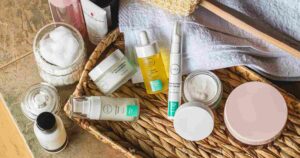2024 saw a renaissance in the beauty industry. Although sales figures are not what they were before the pandemic, cosmetic markets in both the US and Europe saw a good bounce back in sales. The caveat is that buyers are trying to adjust to a work-life balance.
This is why they are investing in quick and low-maintenance looks (adopted during the COVID-19 pandemic), giving way to flexible, low-key beauty trends. Moreover, thanks to rising inflation, people are prioritizing fewer products that deliver maximum impact to try to save some money.
This rise in minimalist beauty or skincare is leaving its mark on the industry and forcing companies to introduce new beauty regimes. Still, some people on the other end of the spectrum don’t want to make any compromises on their beauty regime.
If you are confused about this minimalist vs. maximalist skincare approach, we will break down both regimes and help you pick the right one for yourself.
Minimalist

Minimalist (in the context of design) uses the fewest elements possible to achieve maximum impact. This approach had its roots in artwork featuring simple lines consisting of only a few colors and careful placement of those lines and colors. When you bring this approach to skincare, it translates to a quick and easy beauty regime that gets the job done without consuming too many products or too much time.
Minimalist skincare comprises only a few products, including a cleanser, moisturizer, and sunscreen. It seems basic, but it gives your skin essential hydration and protection. Minimalist skincare is ideal for people with healthy skin who want to keep it that way.
Moreover, using too many products can do more harm than good; it adversely affects your skin’s ability to protect and maintain itself and sometimes causes reactions or irritation.
How to Create a Minimalist Skincare Routine?
Minimalist skincare evolves around three steps, and we are giving you a breakdown of it:
- Start with a Cleanser
A non-negotiable step in all skincare regimes is to clean your skin. Remove debris, makeup, and pollutants from the skin’s surface before you apply any new products. This makes the perfect base for these products to be absorbed.
- Use Serum for Your Skin Issues
We’ve skipped toner because it doesn’t cut for a light yet effective skincare routine. Yes, you’d be better off with a good quality serum that caters to your skin’s issues. To help you understand, let us explain that serums are made with a concentration of specific specialized ingredients that target particular skin issues.
Yes, a toner can do the same, but toners also balance your skin’s pH, whereas a serum (if you pick the right one) can do much more.
- Moisturize Your Skin with SPF
Serums are expensive, so better lock their benefits with a good moisturizer. You can pick a moisturizer based on your preference, like something light or heavy or one with SPF. Whatever you do, make sure you end your skincare regime with sunscreen.
Yes, sunscreen (with SPF) is a vital part, and it might make the fourth step, but honestly, it doesn’t matter what you do with your sun if you are not keeping it safe from the sun. If you don’t want a fourth step, then as we said earlier, use a moisturizer with SPF 30.
Read more: The 10 Best Moisturizers After IPL Treatment
Pros
- It helps you do more for less; you save money, time, and storage space
- With less product build-up and the right products, you cut the chance of a skin reaction or irritation
- Sometimes, not bombarding your skin with chemicals and letting nature take its course can help your skin become more radiant
- You can easily carry your skin routine with you all the time (ideal for frequent travelers)
Cons
- It doesn’t let you entertain specific skin issues, like acne, sensitivity, etc.
- Minimalist skincare doesn’t suit all situations; you might need more products or steps based on where you live, your skin condition, and other aspects.
Maximalist

Maximalist means “more is more,” and maximalist skincare is a multi-step beauty routine, usually 7-8 steps (at least). If you can afford a detailed and luxurious beauty routine, then Maximalist skincare is for you.
A maximalist beauty regime goes beyond the clean, moisturize, and protect motto. Instead, it gives you room to adjust your skincare according to your skin’s unique needs, as you can add products to target issues like fine lines, signs of aging, or any skin issues you have.
How to Create a Maximalist Skincare Routine?
We are breaking down the maximalist skincare routine below:
- Prep Your Skin
Prep your skin by starting with a face wash. Cleaning the debris and pollutants on your skin’s surface helps absorb the rest of the products better.
- Retain Its Natural Moisture
Once cleaned, retain your skin’s natural moisture with a toner. If you have troubled patches, you can use a chemical toner.
- Pay Attention to Your Eyes
Keep your eyes supple and fight off dullness, baggy, puffy eyes, or uneven tones with an eye cream. The area around your eyes is delicate, so you better pay attention.
- Tend to Your Skin Issues
If your face has texture issues, feels dull, or you are seeing signs of early aging, then use a serum. Pick a serum according to your skin so it’s light, works fast, and is easy to absorb.
- An Optional Step
If your skin is prone to acne breakouts or has some trouble spots, add spot treatment to your regime as an extra step. Yes, ingredients like Salicylic Acid and Benzoyl peroxide help you fight off several skin issues, including redness, inflammation, etc.
- Moisturize Your Skin
Keeping your skin supple and hydrated is the key to having great skin. Yes, you can fend off signs of aging, dullness, and acne with moisture. Also, let’s not forget doing so makes your skin soft and vibrant (as well).
- Lock-In Everything
It’s time to lock in everything with face oil. When choosing one, look for rich antioxidants and antibacterial properties with essential fatty acids. Doing so ensures your skin doesn’t get dry but doesn’t look greasy or oily afterward.
- Sunscreen
Don’t forget to protect your skin. Add sunscreen with SPF 30 to your skin regime. Block the sun’s harmful rays to keep your skin from aging and keep your younger look for longer.
This skin regime helps cure most skin issues, but thanks to the rise in minimalist skin care, people find it too complex or lengthy, especially in the morning when you have to leave for work. Still, considering these approaches, weigh their pros and cons.
Pros
- If you have a skin issue, maximalist skincare can help you here
- These routines are flexible in letting in any product or ingredient; make sure it doesn’t disrupt your skin
- It lets you fine-tune your product and commit to its long-term benefits (if you can afford them)
- It helps your skin become tolerant to future changes in your skincare regime
Cons
- If you don’t have enough time to spare for your skin every day, or you find it hard to keep up with a 7-8-step skincare regime
- Your wallet doesn’t have the room for it (an obvious one)
Choosing a Skincare Regime for Yourself
Simply put, it all boils down to what you want and need. Dedicate some time to yourself; it’s always worth it. Yes, the skincare market is booming with new products. So, finding the right fit for yourself can be challenging.
If this feels overwhelming, we recommend you go to a dermatologist. In case you want to compile your skincare routine yourself, then we have a few tips that can help you get it right:
Some Basics
You should know everyone has a different skin, like any other skin type, skin issues, concerns, goals, and so on. Still, there are some essential skincare rules you should follow. First, learn about your skin type and consider your primary skincare concerns and goals. Once you have that right, you can look forward to building a skincare routine.
Start with a Simple Daily Routine
You don’t need to go big at the start. Keep things simple, start with the basics, and expand (or keep building), as the basics are always about Cleaning, Moisturizing, and Protecting. It is a relatively minimalist approach, but it’s safe, especially considering your limited knowledge about skincare.
Pick the right products according to your skin issues and your end goals. Use these products for a while, see how they sit well with your skin, and make changes as necessary. You can make changes or add extra steps as you get a hang of your routine.
Add and Change Extra Steps
You can add extra steps to your skincare regime as you need/want. Once again, keep things simple here. Try to target specific areas or skin issues with this extra step, like adding a face serum that you can layer underneath them. As can also add a face mask here. Also, you can add steps weekly or bi-weekly instead of daily. For instance, you can use a face mask every week. It helps hydrate, clarify, and calm your skin. Doing it weekly is safe, or you will bombard your skin with chemicals if you do it daily, which will pave the way for a reaction or acne breakout.
Be Patient and Consistent
When you start a skincare routine or change it and it doesn’t seem to work at the start, making quick changes won’t help. Instead, be patient and give your skin time to get used to the routine or your changes.
Your skin needs anywhere between 2 and 3 months to get used to a new product or agent, so at least wait for 3 months before you change again. Also, be consistent with your effort; consistency is the key to achieving your end goal. If you can’t continuously keep up your regime for at least six months, then you shouldn’t expect any results. You need a combination of both of these to succeed at your skincare game.
The End Word
So, which one you should go with, Minimalist or Maximalist Skincare?
No skincare regime will work for you if you don’t work it up. Make some changes according to your skin, lifestyle, and diet. You should know skin trends aren’t disappearing; you need to know what works for you. Skin health is personal, and it has a learning curve. Learn to listen to your skin and its reaction to specific trends, products, and diet. Listen to your skin because not every trend is meant for you.
If you have a skin issue like acne, rosacea, or psoriasis, you should consult a dermatologist. They can help you make a well-informed decision.

 By myulikeadmin
By myulikeadmin



